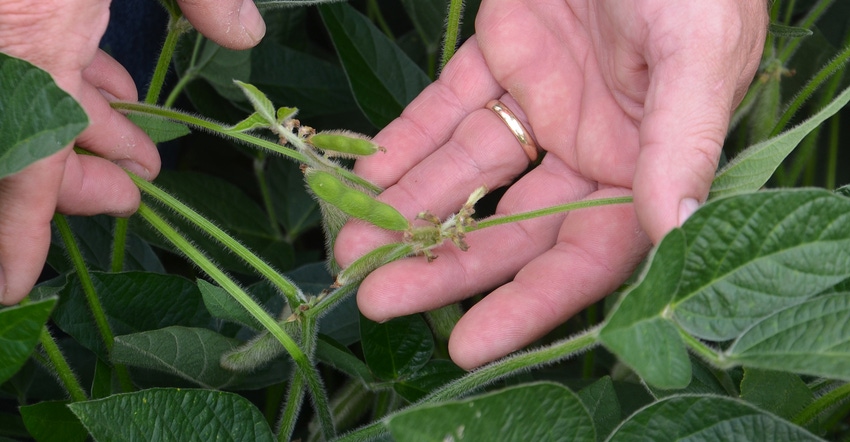
Steve Gauck was optimistic when he visited the Soybean Watch ’21 field in early August. There was an adequate number of plants, and branching was adding pods. Except for some vole holes and scattered volunteer corn plants, the stage seemed set for good yields.
In fact, he found several four-bean pods and lots of three-bean pods. Moreover, he was finding large numbers of pods and short internodes, especially on the two out of three varieties in the field that were of shorter stature. The fullest-season bean was taller and was still setting new pods at the tops of plants.
Related: Weed pressure hard to miss from air
“The field had plenty of rain for most of July, and then the spicket turned off,” Gauck observes. Unless rains returned during the critical pod fill time at the end of August and running well into September, he fears some of those four-bean pods became three-bean pods. Some three-bean pods will drop to two beans per pod. And some plants will abort some pods.
“Seed size is the other key consideration,” Gauck says. “Seed size is set to some degree by genetics, but weather during the key pod fill stage can result in larger seeds. If there isn’t enough moisture, seed size will drop quickly.”
Mitigating factors
This Soybean Watch ’21 field has two things in its favor if dry weather continued.
First, Gauck says all season long, when he pulled up plants to check roots, the tap roots were exceptionally long, meaning they’re heading deeper into the soil. “Tap roots can pull in quite a bit of water for the plant,” he says. “They’re not nearly as effective as hair roots in bringing in nutrients, but they can supply water.”
Second, the field was no-tilled into a relatively heavy cover of cornstalks. Conventional wisdom has always held that no-till fields, especially those with corn residue cover, can hold moisture better later in the season than conventionally tilled fields.
That theory is being put to the test. The adjacent field is a conventionally tilled field, planted to the same variety as one in the Soybean Watch field. The conventional field was planted one day earlier. Mike Thurow of Spectrum Technologies provided a weather station that will accept readings from two soil moisture sensors so that conditions in the two fields can be compared. There is a sensor about 6 inches deep under a row in each field. The rows are about 10 feet into their respective fields.
Volumetric water content tracked 6 or more percentage points higher in the no-till field vs. the conventional field nearly all season, until it got very dry. When soils are saturated, VWC is only somewhat above 40%. When it drops below 20%, moisture supplies are getting low. On Aug. 18, the VWC for the no-till field was 11.8%, while the conventional field was at 7.7%, also its lowest to date. Perhaps season-saving rains fell the week of Aug. 23, and moisture contents rebounded, at least temporarily.
About the Author(s)
You May Also Like




